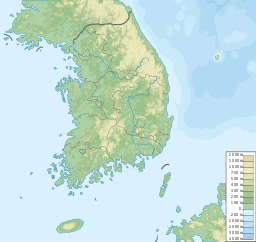Maenggol Channel
| Maenggol Channel | |
|---|---|
| 맹골수도 (Korean) | |
| Location | Yellow Sea |
| Coordinates | 34°13′N 125°53′E / 34.22°N 125.89°E |
| Basin countries | South Korea |
| Max. length | 6 km (3.7 mi) |
| Max. width | 4.5 km (2.8 mi) |
The Maenggol Channel (Korean: 맹골수도; RR: maenggolsudo) or Maenggol Sudo or Maenggol Waterway is a sea channel named after the Maenggol Island south-west of the Korean Peninsula. Stretching 4.5 kilometres (2.8 mi) wide between the Geocha Archipelago and the Maenggol Archipelago and running south-east for 6 kilometres (3.7 mi),[1] the channel has provided a shortcut for ships that try to save fuel and time.[2]
The Maenggol Channel has one of the most rapid and unpredictable currents in the Korean Peninsula due to tidal shifts.[3][4][5] A 2012 study estimating the prospective tidal current energy resources off the south and west coasts of Korea ranked Maenggol Channel second in South Jeolla Province only surpassed by Myeongnyang Strait that already features the Uldolmok Tidal Power Station.[6]
In April 2014, the passenger ferry MV Sewol capsized in the Maenggol Channel north of the island Byeongpungdo, and sank off the coast of Donggeochado.[7][8]
References[edit]
- ^ Prostar Sailing Directions 2004 Korea & China Enroute. ProStar Publications. 1 January 2004. pp. 50–. ISBN 978-1-57785-561-3.
- ^ Choe Sang-Hun and Su-Hyun Lee (20 April 2014). "Korean ferry pilot was negotiating treacherous waterway for first time, prosecutors say". The Boston Globe. Retrieved 13 June 2014.
- ^ Jin, Moyoun (24 April 2014). "Sewol sinking puts pressure on IMO" (PDF). IHS Maritime Fairplay. IHS. pp. 8–9. Archived from the original (PDF) on 14 July 2014. Retrieved 13 June 2014.
- ^ "Sewol sinking puts pressure on IMO". Ihsmaritime.wordpress.com. 24 April 2014. Archived from the original on 14 July 2014. Retrieved 13 June 2014.
- ^ Sang-Hun, Choe; Lee, Su-Hyun (19 April 2014). "Divers Begin Bringing Bodies Out of Capsized Ferry". The New York Times.
- ^ Byun, Do-Seong; Hart, Deirdre; Jeong, Woo-Jin (2013). "Tidal Current Energy Resources off the South and West Coasts of Korea: Preliminary Observation-Derived Estimates". Energies. 6 (2): 566–578. CiteSeerX 10.1.1.388.8008. doi:10.3390/en6020566. ISSN 1996-1073.
- ^ Ralph Ellis, KJ Kwon and Greg Botelho (20 April 2014). "Transcript: Passengers couldn't escape South Korean ferry, crew member says". CNN World.
- ^ "(4th LD) Rescuers fight time to find hundreds missing in sunken ferry". English.yonhapnews.co.kr. Yonhap. 19 April 2014. Retrieved 13 June 2014.
External links[edit]

